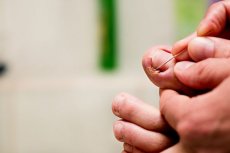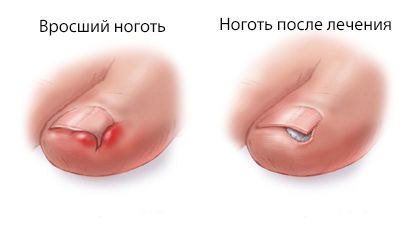Medical expert of the article
New publications
Ingrown toenail removal
Last reviewed: 04.07.2025

All iLive content is medically reviewed or fact checked to ensure as much factual accuracy as possible.
We have strict sourcing guidelines and only link to reputable media sites, academic research institutions and, whenever possible, medically peer reviewed studies. Note that the numbers in parentheses ([1], [2], etc.) are clickable links to these studies.
If you feel that any of our content is inaccurate, out-of-date, or otherwise questionable, please select it and press Ctrl + Enter.

Removal of an ingrown nail can be done in several ways. The most common and effective of them are such methods as marginal excision of the nail plate with the growth zone and cauterization of the affected area, as well as laser therapy and radio wave treatment.
Surgical intervention aimed at marginal excision of the nail plate with electrocoagulation of the growth area allows to narrow the nail plate and make the skin fold on the sides of the nail plate smaller. When using this method, the probability of recurrence is minimal.
Resection of the nail plate with subsequent cauterization of the growth zone is performed under local anesthesia. A lidocaine solution is injected into the damaged finger, after which the affected area becomes numb within five minutes.
After the procedure, the patient must limit the load on the injured limb for 24 hours; bed rest is recommended. Analgesics are prescribed to relieve pain.
On the second day, the sore finger is bandaged, and then, if necessary, this procedure is performed daily or every other day. The patient is allowed to walk from the second day after surgery, but motor activity should be minimal. The stitches are removed after seven to ten days if they were applied. If the procedure was performed without stitches, the wound heals in about two to three weeks.
Does it hurt to remove an ingrown toenail?
Anyone who has encountered such a problem as ingrowth of the horny plate undoubtedly has a question about whether it is painful to remove an ingrown nail (onychocryptosis). Modern methods of treating this pathology, such as laser and radio wave therapy, allow you to get rid of such a defect as quickly, effectively and painlessly as possible. All procedures, including surgical removal of onychocryptosis, are performed under local anesthesia, which allows you to minimize the occurrence of pain.
To relieve pain after the procedure of removing an ingrown nail, take analgesics as prescribed by a doctor.
Laser removal
Laser removal of an ingrown nail is the most effective and painless way to eliminate such a defect. When using this method of treatment, the probability of re-ingrowth of the horny plate is minimal. Also, with laser therapy for onychocryptosis, there is no risk of side effects.
Before the laser nail removal procedure, the patient should first undergo tests. If inflammatory processes are detected in the affected area, the patient is prescribed anti-inflammatory and antibacterial drugs. In advanced and severe cases of the disease, an X-ray examination may be performed.
Before the procedure begins, the patient is given local anesthesia, after which the ingrown area and granulation are removed and a bandage with antibiotics is applied.
After the procedure, the patient should limit the load on the affected limb for several days. The wound is bandaged daily. It heals completely in about one to one and a half months. During this period, the patient should not visit the sauna or bathhouse, and shoes should be as comfortable and spacious as possible.
Laser removal of ingrown nails is contraindicated for people with blood clotting problems and diabetes. There are also other severe pathologies in which such a procedure is not recommended. Therefore, before removing an ingrown horny plate using a laser, a consultation and examination by a doctor is required.
The procedure lasts about thirty minutes.
Laser removal of an ingrown nail is performed under local anesthesia and also includes a procedure for cleaning the inflamed area of the side wall of the finger. Laser removal of an ingrown nail, compared to surgical methods, is highly effective and has no contraindications or relapses of the disease.
During laser therapy, only the affected segment of the nail is removed, the nail plate is preserved, and nearby tissues are not damaged. Laser cleansing of inflamed tissues allows for the complete elimination of the inflammatory process and the prevention of negative consequences.
Removing an ingrown nail with a laser is painless and the procedure takes about thirty minutes.
Surgical removal
Surgical removal of an ingrown nail involves excising its lateral portion that is injuring the soft tissue. At the same time, the matrix segment of the horny plate is also excised. To do this, the skin over the affected area is cut, the wound is treated with antiseptics and cleaned. The ingrown part of the nail is removed with a scalpel, the affected area is treated with antibiotics. However, this method of removing an ingrown nail does not provide a 100% guarantee of further correct growth of the nail plate, and the process of ingrowth of the horny plate may occur again.
Removal of the entire nail is indicated in severe cases of onychocryptosis. However, there is a risk of damaging the growth zone of the horny plate, which can lead to its abnormal growth and cause re-ingrowth.
After surgery, the patient needs to be monitored by a doctor for about three to four weeks. Every day or every other day, the affected area is bandaged and treated with antibacterial agents. Complete healing of the wound occurs about a month after surgery.
Methodology of the operation
The operation to remove an ingrown toenail is performed under local anesthesia using a surgical scalpel and scissors.
During the operation, the ingrown portion of the horny plate and hypergranulation, as well as the matrix of the ingrown part of the nail, are removed.
After the anesthetic is administered, a rubber tourniquet is applied to the finger to prevent bleeding.
The soft tissues in the affected area are cut and cleared of hypergranulations. Then, using scissors, an incision is made on the desired area of the horny plate, which is subsequently removed using a clamp. Scraping of the matrix is carried out with a special spoon, as well as by electrocoagulation.
At the end of the operation, stitches and a tight bandage are applied to the affected finger. In the first 24 hours after surgery, you should stay in bed and avoid any loads on the affected leg. To relieve pain, take analgesics as prescribed by your doctor.
Operation Schmiden
The Schmiden operation for an ingrown nail involves resection of a section of the horny plate, lateral ridge and growth zone. After the operation is completed, sutures are applied to the affected tissues. It should be noted that there is a risk of injury when performing such a procedure, and a high frequency of relapse and repeated ingrown nails is also noted.

Tools
During the surgical intervention, a special instrument for ingrown nails is used. At the initial stage of the procedure for removing the ingrown horny plate, an incision is made on the soft tissues of the affected area using a scalpel. Then, the ingrown nail itself is cut with scissors and removed using a clamp. After this, the nail matrix is excised with a special spoon.
Curette
A double-sided curette for ingrown nails is used to clean the nail plate and sinuses from dead tissue. This tool is intended for professional use as an auxiliary method for treating ingrown horny plates.
Radio wave removal
Radio wave removal of an ingrown nail allows you to effectively eliminate inflammatory phenomena in the affected area, as well as preserve intact areas of the nail plate. The impact on soft tissues during radio wave treatment is minimal, and there is no bleeding or scarring.
Radio wave removal of an ingrown nail lasts for thirty minutes, after which a sterilizing bandage is applied to the affected area. The pain that occurs after radio wave removal of an ingrown horny plate is much less pronounced than after surgical intervention. There are practically no cases of repeated nail defects after such treatment.
Radio wave treatment can be performed at any stage of ingrown nail development. After local anesthesia, the ingrown area of the horny plate is eliminated and the growth and matrix zones are treated. No stitches are applied after this procedure, the finger is bandaged with a sterile bandage with disinfectants.
The main advantages of this treatment method are such indicators as complete elimination of the inflammatory process, absence of side effects, a relatively short period of recovery and wound healing and a low percentage of relapses.
Post-operative care
Treatment after removal of an ingrown nail consists of daily treatment of the affected area with antibacterial ointments and dressing of the wound. To relieve pain, the patient is prescribed painkillers. One of the main requirements during the recovery period after removal of an ingrown nail is to ensure complete rest of the affected limb in the first day after the operation.
Then, starting from the second day, the patient is allowed to walk, but the load on the leg should be minimal. The wound is bandaged and treated daily or every other day, depending on the doctor's recommendations. It is necessary to strictly observe hygiene standards and prevent dirt and moisture from getting on the wound. Complete healing usually occurs in four to six weeks.
Bandaging
Bandaging after removal of an ingrown nail is carried out using sterile materials with the use of antiseptic and antibacterial agents. After applying the bandage, it should be avoided from getting wet. Re-bandaging and changing the bandage is recommended the next day after its application. To do this, the used bandage is carefully removed, the horny plate is treated with antiseptics, lubricated with antibacterial ointment and bandaged with a clean and dry sterile bandage.
The procedure of dressing the wound after removing an ingrown nail can be done independently or at a doctor's appointment. The dressing is done daily or every other day, depending on the doctor's recommendations.
Price
The price of removing an ingrown nail depends on the stage of the disease, the chosen method of treatment, and the choice of the clinic where it will be carried out. The approximate cost of laser removal of onychocryptosis is about 1200 UAH. The procedure includes local anesthesia, excision of the problem area, as well as removal and treatment of the inflamed segment of the lateral part of the damaged finger.
Reviews
Reviews of ingrown nail removal using laser therapy highlight such factors as painlessness and speed of the procedure, absence of side effects, and re-ingrowth of the horny plate. While such cases are not uncommon after surgical intervention.


 [
[